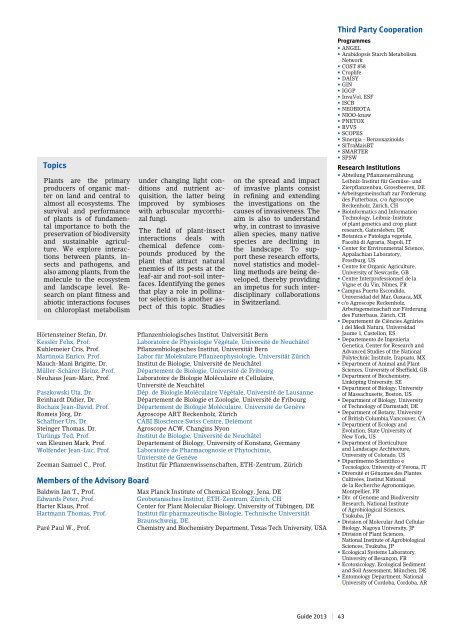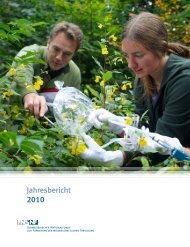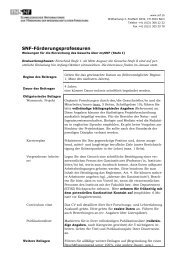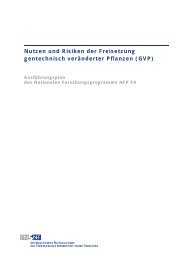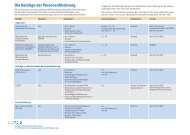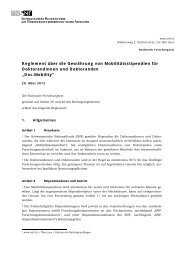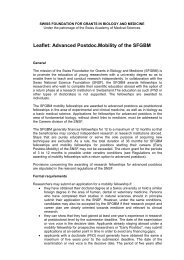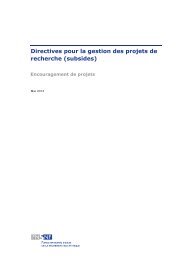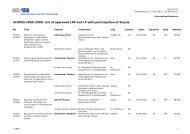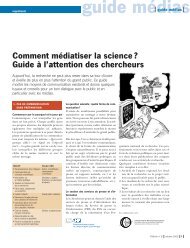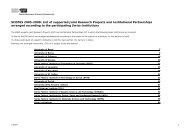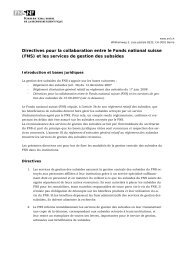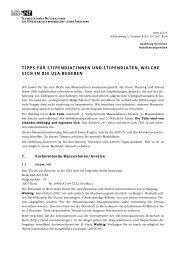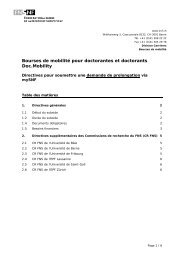NCCR Guide 2013 - Schweizerischer Nationalfonds (SNF)
NCCR Guide 2013 - Schweizerischer Nationalfonds (SNF)
NCCR Guide 2013 - Schweizerischer Nationalfonds (SNF)
Create successful ePaper yourself
Turn your PDF publications into a flip-book with our unique Google optimized e-Paper software.
Topics<br />
Plants are the primary<br />
producers of organic matter<br />
on land and central to<br />
almost all ecosystems. The<br />
survival and performance<br />
of plants is of fundamental<br />
importance to both the<br />
preservation of biodiversity<br />
and sustainable agriculture.<br />
We explore interactions<br />
between plants, insects<br />
and pathogens, and<br />
also among plants, from the<br />
molecule to the ecosystem<br />
and landscape level. Research<br />
on plant fitness and<br />
abiotic interactions focuses<br />
on chloroplast metabolism<br />
Hörtensteiner Stefan, Dr.<br />
Kessler Felix, Prof.<br />
Kuhlemeier Cris, Prof.<br />
Martinoia Enrico, Prof.<br />
Mauch-Mani Brigitte, Dr.<br />
Müller-Schärer Heinz, Prof.<br />
Neuhaus Jean-Marc, Prof.<br />
Paszkowski Uta, Dr.<br />
Reinhardt Didier, Dr.<br />
Rochaix Jean-David, Prof.<br />
Romeis Jörg, Dr.<br />
Schaffner Urs, Dr.<br />
Steinger Thomas, Dr.<br />
Turlings Ted, Prof.<br />
van Kleunen Mark, Prof.<br />
Wolfender Jean-Luc, Prof.<br />
Zeeman Samuel C., Prof.<br />
Members of the Advisory Board<br />
Baldwin Ian T., Prof.<br />
Edwards Peter, Prof.<br />
Harter Klaus, Prof.<br />
Hartmann Thomas, Prof.<br />
Paré Paul W., Prof.<br />
under changing light conditions<br />
and nutrient acquisition,<br />
the latter being<br />
improved by symbioses<br />
with arbuscular mycorrhizal<br />
fungi.<br />
The field of plant-insect<br />
interactions deals with<br />
chemical defence compounds<br />
produced by the<br />
plant that attract natural<br />
enemies of its pests at the<br />
leaf-air and root-soil interfaces.<br />
Identifying the genes<br />
that play a role in pollinator<br />
selection is another aspect<br />
of this topic. Studies<br />
on the spread and impact<br />
of invasive plants consist<br />
in refining and extending<br />
the investigations on the<br />
causes of invasiveness. The<br />
aim is also to understand<br />
why, in contrast to invasive<br />
alien species, many native<br />
species are declining in<br />
the landscape. To support<br />
these research efforts,<br />
novel statistics and modelling<br />
methods are being developed,<br />
thereby providing<br />
an impetus for such interdisciplinary<br />
collaborations<br />
in Switzerland.<br />
Pflanzenbiologisches Institut, Universität Bern<br />
Laboratoire de Physiologie Végétale, Université de Neuchâtel<br />
Pflanzenbiologisches Institut, Universität Bern<br />
Labor für Molekulare Pflanzenphysiologie, Universität Zürich<br />
Institut de Biologie, Université de Neuchâtel<br />
Département de Biologie, Université de Fribourg<br />
Laboratoire de Biologie Moléculaire et Cellulaire,<br />
Université de Neuchâtel<br />
Dép. de Biologie Moléculaire Végétale, Université de Lausanne<br />
Département de Biologie et Zoologie, Université de Fribourg<br />
Département de Biologie Moléculaire, Université de Genève<br />
Agroscope ART Reckenholz, Zürich<br />
CABI Bioscience Swiss Centre, Delémont<br />
Agroscope ACW, Changins Nyon<br />
Institut de Biologie, Université de Neuchâtel<br />
Departement of Biology, University of Konstanz, Germany<br />
Laboratoire de Pharmacognosie et Phytochimie,<br />
Unviersité de Genève<br />
Institut für Pflanzenwissenschaften, ETH-Zentrum, Zürich<br />
Max Planck Institute of Chemical Ecology, Jena, DE<br />
Geobotanisches Institut, ETH-Zentrum, Zürich, CH<br />
Center for Plant Molecular Biology, University of Tübingen, DE<br />
Institut für pharmazeutische Biologie, Technische Universität<br />
Braunschweig, DE<br />
Chemistry and Biochemistry Department, Texas Tech University, USA<br />
Third Party Cooperation<br />
Programmes<br />
• ANGEL<br />
• Arabidopsis Starch Metabolism<br />
Network<br />
• COST 858<br />
• Croplife<br />
• DAISY<br />
• GIN<br />
• IGGP<br />
• InvaVol, ESF<br />
• ISCB<br />
• NEOBIOTA<br />
• NIOO-knaw<br />
• PNETOX<br />
• RVVS<br />
• SCOPES<br />
• Sinergia - Benzoxazinoids<br />
• SiTraMaisBT<br />
• SMARTER<br />
• SPSW<br />
Research Institutions<br />
• Abteilung Pflanzenernährung,<br />
Leibniz-Institut für Gemüse- und<br />
Zierpflanzenbau, Grossbeeren, DE<br />
• Arbeitsgemeinschaft zur Förderung<br />
des Futterbaus, c/o Agroscope<br />
Reckenholz, Zürich, CH<br />
• Bioinformatics and Information<br />
Technology, Leibniz-Institute<br />
of plant genetics and crop plant<br />
research, Gatersleben, DE<br />
• Botanica e Patologia vegetale,<br />
Facoltà di Agraria, Napoli, IT<br />
• Center for Environmental Science,<br />
Appalachian Laboratory,<br />
Frostburg, US<br />
• Centre for Organic Agriculture,<br />
University of Newcastle, GB<br />
• Centre Interprofessionnel de la<br />
Vigne et du Vin, Nîmes, FR<br />
• Campus Puerto Escondido,<br />
Universidad del Mar, Oaxaca, MX<br />
• c/o Agroscope Reckenholz,<br />
Arbeitsgemeinschaft zur Förderung<br />
des Futterbaus, Zürich, CH<br />
• Departement de Ciències Agràries<br />
i del Medi Natura, Universidad<br />
Jaume 1, Castellon, ES<br />
• Departemento de Ingenieria<br />
Genetica, Center for Research and<br />
Advanced Studies of the National<br />
Polytechnic Institute, Irapuato, MX<br />
• Department of Animal and Plant<br />
Sciences, University of Sheffield, GB<br />
• Department of Biochemistry,<br />
Linköping University, SE<br />
• Department of Biology, University<br />
of Massachusetts, Boston, US<br />
• Department of Biology, University<br />
of Technology of Darmstadt, DE<br />
• Department of Botany, University<br />
of British Columbia,Vancouver, CA<br />
• Department of Ecology and<br />
Evolution, State University of<br />
New York, US<br />
• Department of Horticulture<br />
and Landscape Architecture,<br />
University of Colorado, US<br />
• Dipartimento Scientifico e<br />
Tecnologico, University of Verona, IT<br />
• Diversité et Génomes des Plantes<br />
Cultivées, Institut National<br />
de la Recherche Agronomique,<br />
Montpellier, FR<br />
• Div. of Genome and Biodiversity<br />
Research, National Institute<br />
of Agrobiological Sciences,<br />
Tsukuba, JP<br />
• Division of Molecular And Cellular<br />
Biology, Nagoya University, JP<br />
• Division of Plant Sciences,<br />
National Institute of Agrobiological<br />
Sciences, Tsukuba, JP<br />
• Ecological Systems Laboratory,<br />
University of Besançon, FR<br />
• Ecotoxicology, Ecological Sediment<br />
and Soil Assessment, München, DE<br />
• Entomology Department, National<br />
University of Cordoba, Cordoba, AR<br />
<strong>Guide</strong> <strong>2013</strong> | 43


